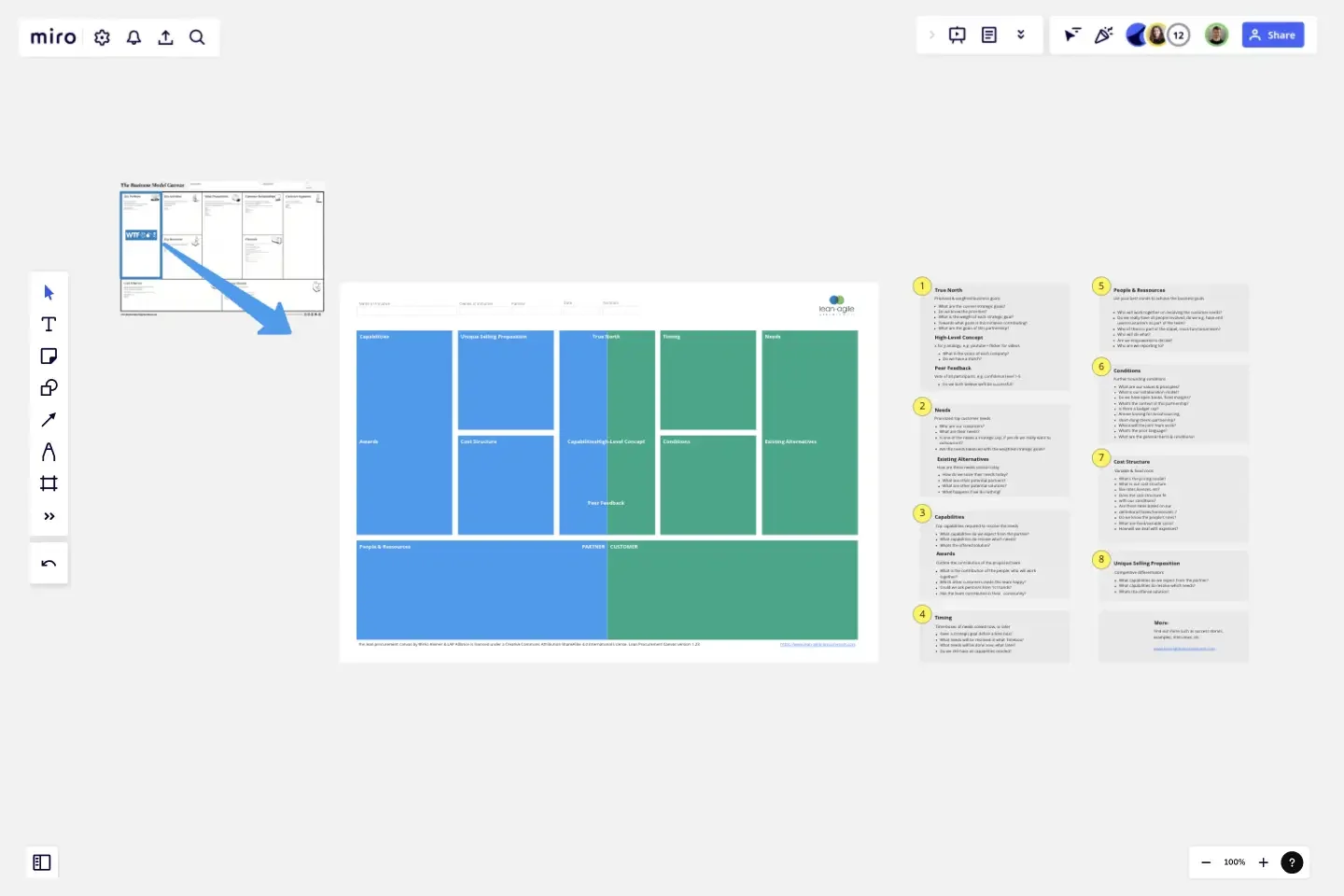Lean Procurement Canvas
With the Lean Procurement Canvas and Lean-Agile Procurement we provide for the very first time a tool and approach that respects agile values and practices during sourcing and/or sales.
For successfully going to market with a new business case, a strong team consisting of internal and/or external people is the foundation. However finding the right complementary people, partners, services or products isn’t easy and takes time. Current sourcing processes and approaches can’t cope with uncertainty and complexity of innovation, new strategic partners, etc.
When should you use the Lean Procurement Canvas?
With the Lean Procurement Canvas and Lean-Agile Procurement we provide for the very first time a tool and approach that respects agile values and practices during sourcing and/or sales. This leads to improved lead times of days/weeks instead of months (from idea to first value delivered), minimizes risk and maximizes business value!
Who is the Lean Procurement Canvas for?
The Canvas can be used by startups, corporations who would like to:
Setup and align a new internal, mixed or outsourced 3rd party agile product delivery team
Co-create an agile agreement with multiple vendors in the same room simultaneously
Assess and manage existing teams or partnerships with 3rd parties
Close a deal more effectively as a vendor
It has been used by Air France KLM, Gazprom, BNP Parisbas, Auckland Council and many more from the private and public sector.
Get started with this template right now.
Design Sprint Retrogram
Works best for:
Agile, Retrospective
The Design Sprint Retrogram template facilitates retrospective sessions for Design Sprint teams to reflect on their experiences and identify improvement opportunities. It provides a structured framework for reviewing sprint outcomes, discussing what worked well, what didn't, and generating actionable insights. This template fosters a culture of continuous learning and refinement, empowering teams to enhance their sprint process and deliver better outcomes in subsequent sprints.
Start, Stop, Continue Retrospective by Laura Timmins
Works best for:
Retrospectives, Agile Methodologies
The Retrospective template offers a flexible and customizable framework for teams to reflect on past experiences and identify areas for improvement. It provides elements for sharing successes, challenges, and action items. This template enables teams to facilitate constructive discussions, generate insights, and drive continuous improvement. By promoting reflection and collaboration, the Retrospective empowers teams to optimize performance and achieve their goals effectively.
Scrum Puzzle
Works best for:
Agile
The Scrum Puzzle is a collaborative activity that reinforces Scrum roles, artifacts, and ceremonies. By assembling a puzzle representing the Scrum framework, teams gain a deeper understanding of its components and how they interrelate. This template offers a fun and interactive way to reinforce Scrum knowledge and promote team alignment, empowering practitioners to apply Scrum principles effectively and deliver value with agility.
Design Sprint Kit Template
Works best for:
Agile Methodology, UX Design, Sprint Planning
With the right focused and strategic approach, five days is all it takes to address your biggest product challenges. That’s the thinking behind Design Sprint methodology. Created by Tanya Junell of Blue Label Labs, this Design Sprint Kit provides a set of lightweight templates that support the Design Sprint’s collaborative activities and voting—and maintains the energy, team spirit, and momentum that was sparked in the session. Virtual sprint supplies and prepared whiteboards make this kit especially useful for remote Design Sprint Facilitators.
What? So What? Now What? Template
Works best for:
Agile Workflows, Retrospectives, Brainstorming
The What? So What? Now What? Framework empowers you to uncover gaps in your understanding and learn from others’ perspectives. You can use the What? So What? Now What? Template to guide yourself or a group through a reflection exercise. Begin by thinking of a specific event or situation. During each phase, ask guiding questions to help participants reflect on their thoughts and experience. Working with your team, you can then utilize the template to record your ideas and to guide the experience.
Blameless postmortem canvas
Works best for:
Agile
The Blameless Postmortem Canvas is a structured framework for conducting blameless postmortems following incidents or failures. It provides sections for documenting the timeline, impact, root causes, and actionable insights. This template promotes a blame-free culture of learning and improvement, enabling teams to analyze incidents objectively, identify systemic issues, and implement preventive measures. By fostering transparency and accountability, the Blameless Postmortem Canvas empowers organizations to learn from failures and enhance resilience, driving continuous improvement and reliability.
